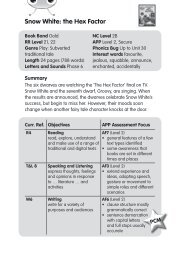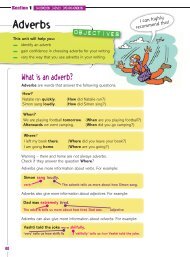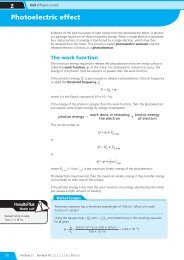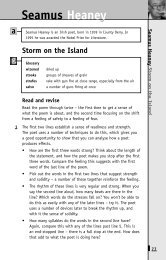INSTALLATION WIRING SYSTEMS ENCLOSURES - Pearson Schools
INSTALLATION WIRING SYSTEMS ENCLOSURES - Pearson Schools
INSTALLATION WIRING SYSTEMS ENCLOSURES - Pearson Schools
You also want an ePaper? Increase the reach of your titles
YUMPU automatically turns print PDFs into web optimized ePapers that Google loves.
Chapter 4: Installation of wiring systems and enclosures<br />
Tool Check for: Optimum performance PPE and other safety advice<br />
Jig saw<br />
• Damaged lead and plug<br />
• Damaged insulation<br />
• General damage<br />
• Faulty on/off switch/trigger<br />
• Loose blade clamping screws<br />
• Do not use worn blades.<br />
• Use the right blade for the material.<br />
• If possible use a guide to keep the<br />
saw on the cutting line.<br />
• Eye protection<br />
• Gloves<br />
• Ear protectors<br />
• Secure the workpiece<br />
• Always cut away from yourself<br />
Chapter<br />
4<br />
169<br />
Circular saw<br />
Table 4.7: Using saws safely<br />
Type of hammer<br />
Claw hammer<br />
Ball pein hammer<br />
Lump hammer<br />
Scutching hammer<br />
Mallet<br />
Table 4.8: Different types of hammer<br />
• Damaged lead and plug<br />
• Damaged insulation<br />
• General damage<br />
• Faulty on/off switch/trigger<br />
• Check guard is in place and<br />
working properly.<br />
Use<br />
• Do not use worn blades.<br />
• Use the right blade for the material.<br />
• Use a guide to keep the saw on the<br />
cutting line.<br />
Hammers<br />
The hammer is probably the most basic item in the electrician’s toolbox and<br />
is used for a wide variety of jobs, such as knocking in nails and driving a<br />
chisel through masonry or wood. Hammers are generally graded according<br />
to the weight of their head.<br />
The claw hammer is two tools in one. The hammer face is<br />
used for general work and the claw is used for removing<br />
unwanted nails and other levering tasks. To remove a nail,<br />
the head is gripped between the two blades of the claw and<br />
the top of the hammer used as the fulcrum of a lever action.<br />
Like the claw hammer, the ball pein is a combination tool<br />
with a standard striking face and a rounded second face.<br />
The ball pein was originally designed for driving in rivets.<br />
1st Proof<br />
Lump hammers are a heavy, block-headed tool usually used<br />
in combination with a cold chisel. This is a heavy tool so<br />
make sure you select a weight that is comfortable. A large<br />
two-handed version of the lump hammer is the sledge<br />
hammer, used for breaking up concrete and for general<br />
demolition type work.<br />
Used by electricians for cutting chases, the scutching<br />
hammer has replaceable blades or teeth that fit into each<br />
end of its head.<br />
The mallet can be either wood or a nylon type head. Mallets<br />
are used mainly in combination with wood chisels. The<br />
softer versions are also used for dressing cables, particularly<br />
mineral insulated, although they must be used with care<br />
when carrying out this type of job because striking the<br />
cable too hard could damage or misshape its outer sheath.<br />
• Eye protection<br />
• Gloves<br />
• Ear protectors<br />
• Secure the workpiece<br />
• Always cut away from yourself<br />
if using a hand-held version<br />
Progress check 4.2<br />
1 Why is a retractable bladed<br />
knife a safe option for the<br />
electrician?<br />
2 In which direction should<br />
the teeth of a hacksaw<br />
blade face?<br />
3 What type of saw is used<br />
for cutting holes in<br />
plasterboard walls?<br />
!<br />
Safe working<br />
Always remember the following<br />
safety guidelines.<br />
• Never use a hammer if the<br />
head is loose.<br />
• Do not use if the handle is<br />
cracked or greasy.<br />
• Check the impact face of a<br />
hammer – if the edges are<br />
cracked or curled back, do<br />
not use.<br />
• Wear gloves and eye<br />
protection when using a<br />
hammer – nails can break off or<br />
fly out if mishit.<br />
Unit<br />
GH8<br />
169
















